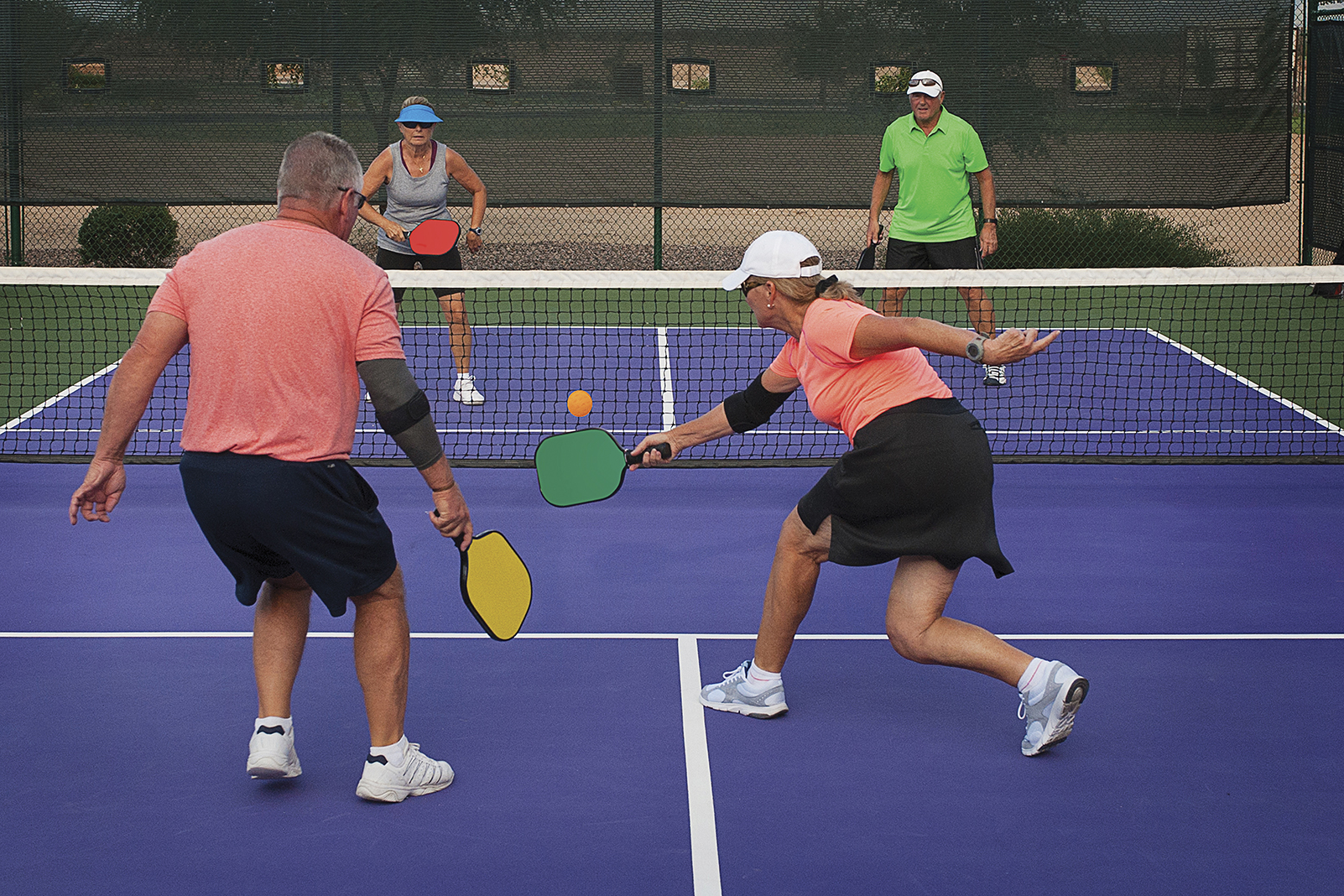
Parents may be familiar with the adage that boredom breeds ingenuity. Pickleball, a racket sport that has become a popular escape in the last few years, was born from that familiar situation.
In 1965, Joel Pritchard, Bill Bell, and Barney McCallum invented the game while vacationing together on Bainbridge Island, near Seattle. After returning from a game of golf to find their children complaining of nothing to do, the three dads decided to create a fun summer activity for their kids by using an old badminton court, pingpong paddles, and a perforated plastic ball. The three started with a badminton net but, after learning that the ball bounced well on the asphalt, lowered the net to work bounces into the game. The pingpong paddle fared well enough, but the inventors decided a larger paddle would be better. They made their way to the Pritchard’s shed and fashioned the first pickleball paddles out of plywood.
As for the name, conflicting stories have surfaced. Some say that the game was named after the McCallum’s family dog, while others contest that it was inspired by the phrase “pickle boat,” a rowing term referring to a mismatched crew-boat team.
The general population has learned that pickleball is easy to learn and fun for any group, regardless of age, gender, or fitness level. In 2021, according to the sport’s national governing body, USA Pickleball, there were 4.8 million players in the United States, an increase of 39.3% in two years.

Locally, indoor courts help participants get exercise in the winter, while outdoor courts served as an escape during the initial peak of COVID-19. Communities continue to add new courts or retrofit indoor and outdoor tennis courts for play. At press time, the metro area was home to 50 courts, and an online resource for players, called Pickleball Portal, listed St. Paul as the second-most popular city in the U.S. for pickleball.
New courts continue to sprout up all over the metro. Minneapolis Cider Company, in the Marcy-Holmes neighborhood of Minneapolis, added a few courts to its space in late 2019, mixing socialization, exercise, and good cider. Josh Kaiser, of Eagan, frequents the courts at the cidery. “I like it because it’s easy to learn but it takes time to master,” Kaiser says. “It can be played at any level of competitiveness and is still a blast to play.”
Sebastian Paradise, of Bloomington, says he learned to play with his grandmother and her partner. “I like that even though we have about a 50-year age difference, we can still play each other or be on the same team and be competitive,” he says.
Elsewhere, Staring Lake Park in Eden Prairie added six courts in 2018, and the Minneapolis Department of Parks and Recreation is looking to add pickleball courts around Lake Nokomis and in Loring Park. In Chaska, three pickleball courts were added to the top of the SouthWest Transit parking ramp last year. According to news reports, the conversion was suggested after the high number of people working from home during the pandemic left the ramp frequently empty.
Southwest of the Twin Cities, in Mankato, the Picklebarn is planned to open this year to provide a space for tournament-level pickleball matches, as well as tennis, cornhole, and pingpong facilities. And the West Des Moines-based company Smash Park announced it will be opening two new venues in the Twin Cities, similar to its flagship location in Iowa, over the next two years.
Minnesota-based Life Time is also betting big on the sport by spending up to $75 million to renovate pre-existing clubs for pickleball courts. According to media reports, Life Time’s 100-plus locations nationwide aim to house more than 300 pickleball courts by the end of this year, and double that by the end of 2023. The Bloomington North location has been renovated for five pickleball courts and will be the company’s first location with a pickleball focus. All five courts will be at the “international competitive” level, and the gym has a large viewing area for tournaments and casual play. Life Time’s CEO, Bahram Akradi, reportedly plays the game himself, referring to it as “accessible to everyone and easy to learn.”
Getting Started: Pickleball, for two or four players, is easy to learn. The players use paddles to hit a whiffle ball over a low net. The court is the same size and layout as a badminton court, with a net, and the rules are similar to tennis.
Keeping Score: Only the serving team can score points. Games go to 11 points, but the winning team must be up by at least two points. Both players of one team get to serve before the ball switches sides. The server calls out the score in a series of three numbers: The serving team’s score is first, by the receiving team’s score, and then the number one or two, for the first or second server—an example being 6-4-2, which means the serving team has six points, the receiving team has four, and the second server has the ball.
Switching Off: When it’s time to serve, a player serves underhand from behind the baseline. The first serve is always crosscourt, delivered from the right side of the court, and serves alternate sides after each point. A player serves until their team commits a fault, whether that means hitting a net, missing the ball, knocking the ball out, or some other offense. After that, the second player gets a chance to serve. Once both players have served and both have committed a fault, the serve goes to the other team. If there are only two people playing, the serve switches teams after every fault.
Some rules to know:
• The ball must cross the court diagonally from the server and bounce once before the player on the opposing team can return the serve. Once the ball is returned by the opposite team, the serving team must again allow the ball to bounce before they can hit it. Once the second bounce occurs, the teams can then volley the ball from the air or off a bounce.
• Players can’t hit the ball from the non-volley zone (also known as the kitchen) unless the ball bounces in the non-volley zone first. In other words, the ball can’t be hit from the air by a player who is in the kitchen.
Pickleball paddles can be found in most sporting-goods stores as well as online and can range in price from $10 to $150. Basic and cheap paddles do the job for beginners. As players begin to advance, it may be time to consider a paddle that fits their hand and play style.
The edge guard: This protective guard around the edge of the paddle saves it from normal wear and tear. If you’re looking to buy a nicer paddle and spend some money on it, an edge guard can help protect your investment.
The right fit: Your hand should play a part in the paddle you pick, as well. Take the time to pick up and swing different paddles to make sure it’s a weight you can play well with and a size that fits your grip properly.
The three types:






